
Black Canyon of the Gunnison National Park is an American national park located in western Colorado and managed by the National Park Service. There are two primary entrances to the park: the south rim entrance is located 15 miles (24 km) east of Montrose, while the north rim entrance is 11 miles (18 km) south of Crawford and is closed in the winter. The park contains 12 miles (19 km) of the 48-mile-long (77 km) Black Canyon of the Gunnison River. The national park itself contains the deepest and most dramatic section of the canyon, but the canyon continues upstream into Curecanti National Recreation Area and downstream into Gunnison Gorge National Conservation Area. The canyon's name owes itself to the fact that parts of the gorge only receive 33 minutes of sunlight a day, according to Images of America: The Black Canyon of the Gunnison. In the book, author Duane Vandenbusche states, "Several canyons of the American West are longer and some are deeper, but none combines the depth, sheerness, narrowness, darkness, and dread of the Black Canyon."
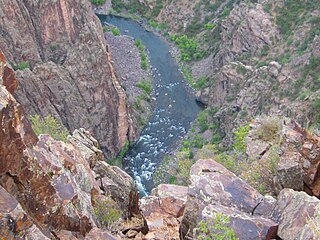
The Gunnison River is located in western Colorado, United States and is one of the largest tributaries of the Colorado River.

Gilia capitata is a species of flowering plant in the phlox family known by the common names blue-thimble-flower, bluehead gilia, blue field gilia, and globe gilia.

Artemisia nova is a North American species of sagebrush, known by the common name black sagebrush. It is "one of the most common shrubs in the western United States".
Gilia yorkii is a rare species of flowering plant in the phlox family known by the common names Boyden Cave gilia and monarch gilia. It is endemic to Fresno County, California, where it is known from only one location in the southern Sierra Nevada. This plant grows in rock cracks in the limestone cliffs and outcrops in the chaparral and woodlands of the canyon.
Heterotheca monarchensis is a rare species of flowering plant in the family Asteraceae known by the common names monarch goldenaster and sequoia false goldenaster. It is endemic to Fresno County, California, where it is known from only one location near Boyden Cave in the Kings River Canyon. It grows in the limestone cliffs of this Sierra Nevada river canyon, along with a few other rare local endemics. The plant was discovered in July, 1995, and described to science as a new species in 1996.
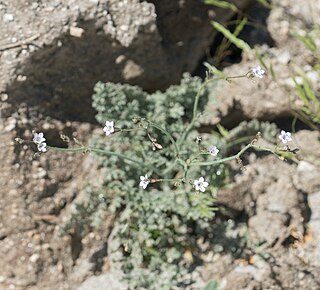
Saltugilia latimeri is an uncommon species of flowering plant in the phlox family known by the common name Latimer's woodland gilia. It is endemic to California, where it is known from several scattered occurrences in the western Mojave Desert and outlying areas to the north. It occurs in dry rocky and sandy desert canyons. It was first described as a species in 2001.
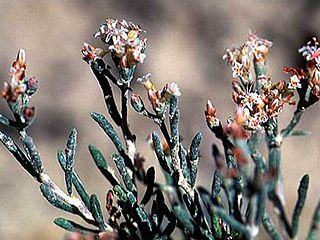
Eriogonum pelinophilum is a rare species of wild buckwheat known by the common name clay-loving wild buckwheat. It is endemic to the state of Colorado in the United States, where it is known from only two counties. The most recent estimates available suggest there are 12 occurrences in existence for a total of about 278,000 individual plants in Delta and Montrose Counties. At least 7 occurrences observed in the past have not been relocated but are not yet believed extirpated. This plant is federally listed as an endangered species of the United States.
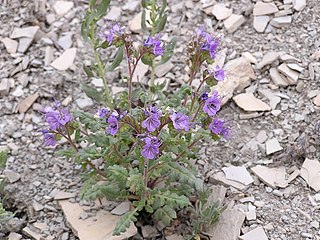
Phacelia argillacea is a rare species of flowering plant in the borage family known by the common names clay phacelia and Atwood's phacelia. It is endemic to Utah in the United States, where it is known only from one canyon in Utah County. It is "one of Utah's most endangered species"; it is "one of the nation's rarest plants" and is federally listed as an endangered species of the United States.

Schoenocrambe argillacea is a rare species of flowering plant in the mustard family known by the common names clay reed-mustard, Uinta Basin plainsmustard, and clay thelypody.
Sedum moraniii is a rare species of flowering plant in the family Crassulaceae known by the common name Rogue River stonecrop. It is endemic to Oregon in the United States, where it only grows in Josephine County next to the Rogue River.

Heterotheca shevockii is a rare species of flowering plant in the family Asteraceae known by the common names Kern Canyon false goldenaster and Shevock's goldenaster. It is endemic to California in the United States, where it is known only from Kern County. It grows along a 21-mile stretch of the Kern River.
Aliciella sedifolia is a rare species of flowering plant in the phlox family known by the common name stonecrop gilia. It is endemic to Colorado in the United States, where it is limited to a small area in the San Juan Mountains.
Mentzelia densa is a species of flowering plant in the Loasaceae known by the common names Royal Gorge blazingstar and Royal Gorge stickleaf. It is endemic to Colorado in the United States, where it occurs in the Arkansas River Valley in Fremont and Chaffee Counties.

Penstemon degeneri is a species of flowering plant in the plantain family known by the common name Degener's beardtongue. It is endemic to Colorado in the United States, where it occurs in and around the Arkansas River Canyon in Fremont, Custer, and Chaffee Counties.
Astragalus anisus is a species of flowering plant in the legume family known by the common name Gunnison milkvetch. It is endemic to Colorado in the United States, where it is limited to the Gunnison Basin of Gunnison and Saguache Counties.
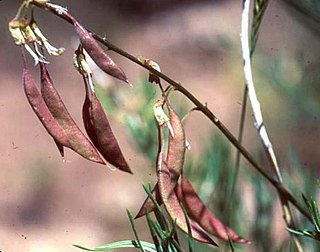
Astragalus ripleyi is a species of flowering plant in the legume family known by the common name Ripley's milkvetch. It is native to southern Colorado and northern New Mexico in the United States.
Astragalus wetherillii is a species of flowering plant in the legume family known by the common name Wetherill's milkvetch. It is native to Colorado and Utah in the United States.

Cirsium perplexans is a species of flowering plant in the family Asteraceae known by the common names Rocky Mountain thistle and Adobe Hills thistle. It is endemic to Colorado in the United States, where it occurs in the Colorado and Gunnison River Valleys in the Rocky Mountains.












